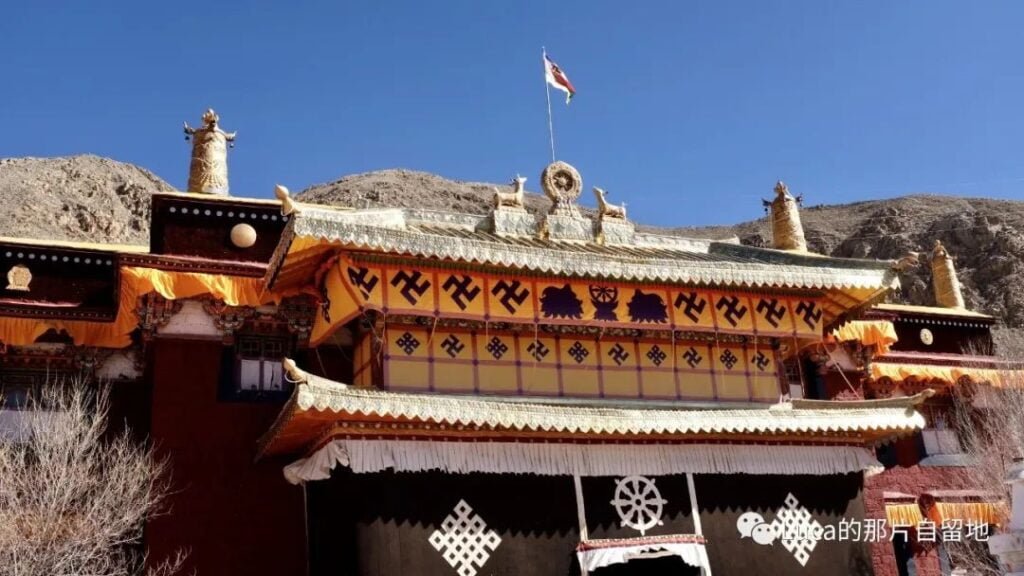The temple sign reads “Meiwu Lunzhu Tongmenlin Temple.” It is located in Shangri Village, Tarong Town, Nimu County, within a vast area. This temple can be found on a hillside. Bon Religion, the indigenous faith of the Qinghai-Tibet Plateau, is represented by Mizhu Tongmenlin Temple, the only surviving temple in Lhasa. However, there are still many remnants of this religion, with the most famous being the remains of Zhilong Temple in Duilongdeqing.

Drilong Bon Monastery
Drilong Temple used to be the largest Bon faith temple in Lhasa, and it is said to have been larger than Drepung Temple at present. Drilong Temple was constructed in 1088 and was destroyed by soldiers of the Junggar tribe of Mongolia in 1718. Over 600 years of prosperity and 300 years of desolation have resulted in the current ruins. This is also due to the fact that after the 18th century, the Gelug Sect of the Yellow Sect gradually gained dominance in Tibet, making it even more challenging for Bon Religion temples to recover.

Compared to the immense ruins of Drilong Temple, Mizhu Tongmenlin Temple is much smaller. The temple sits on a mountainside, with the sacred mountain behind it resembling a king’s throne, the left foothills resembling a descending dragon, and the right foothills resembling white silk and satin. However, the temple now only has two monks. When we reached the entrance, it was closed. We planned to find another entrance, but to our surprise, a young man opened the gate from the inside.
Symbols in Bon Religion

Many individuals enjoy debating the ambidexterity of the swastika, as the symbol’s association with the head of state has tarnished its original auspicious meaning. According to a credible source, the original symbols can be both left-handed and right-handed, depending on the dexterity of the person drawing them. However, upon closer inspection, the swastika depicted in the photograph above, with its 45-degree tilt, initially resembles the symbol associated with the head of state. Yet, upon further scrutiny, it is actually left-handed, while the head of the state’s symbol is right-handed.

Rituals in Bon Religion
The most apparent distinction of the Bon religion is its contrasting rituals to Buddhism. A prime example is the clockwise rotation of Buddhist temples around pagodas, while Bon religious temples rotate counterclockwise. Even the depiction of the six realms of reincarnation on the wall outside the main hall appears to have reversed directions for hell and heaven, differing from other temples.

Although many rituals are inverted, the Bon religion and Buddhism are not completely divergent religions that contradict each other. one even perceives the Bon religion as a sect within Tibetan Buddhism. There are numerous perplexing aspects to Bon religion, and one may not have a comprehensive understanding.
Yongdrung Bon – Swastika
Firstly, “Bon Religion” and “Yongdrung Bon Religion” are two distinct concepts with a progressive relationship. The acknowledged founder of Yongzhong Bon is Master Shenrab Miwoche, who initially propagated it in the ancient Zhang Zhung civilization situated alongside Gangdise Mountain. Yongdrung Bon is an evolution of the “Bon religion” and has been perpetuated.

According to the myth, Master Shenrab Miwoche is the prince of the Zhang Zhung Kingdom. Although there are varying opinions regarding his birth date, in terms of status, he holds the same position as Sakyamuni in the Yongzhong Bon religion. They are both princes, and they both engage in spiritual practice and preaching. Master Shenrab Miwoche and Sakyamuni are truly alike. The ancient Zhang Zhung, situated in the Ngari region, can be considered the centre of the earliest civilization on the Qinghai-Tibet Plateau. However, the name “Ancient Zhang Zhung” is even more perplexing. Due to the scarcity of historical records and various later speculations, it is challenging to clarify the history of Zhang Zhung before it was conquered by Tubo.
Meiwu Lunzhu Tongmen Ling Temple
Setting aside the ambiguous tales from thousands of years ago, let’s focus on Meiwu Lunzhu Tongmen Ling Temple. The explanatory board in this temple also refers to it as “Sangri Songguo,” which means a grand temple with three thousand monks. When the temple was initially established in the 12th century, it did indeed have such a large scale. In 1985, the government provided funds for the restoration of the temple, bringing it back to its original appearance.

According to the information on the temple’s explanation board, the primary deity worshipped here is “Chowo Religious Kachin.” One caught a glimpse of the Buddhist hall through the window outside the main hall. Buddhist temples are quite similar. Throughout the thousands of years of coexistence and conflict, the Yongzhong Bon religion and Tibetan Buddhism have influenced and developed each other, resulting in a merging of their beliefs. Initially, the two may have been distinct and competing religions, but today, there are more similarities than differences.


I’m having difficultly finding this temple in map applications. Can you please share the address in Baidu or Google Maps?
Check out
Duilong Benjiao Zhilong
29.692115, 90.838994